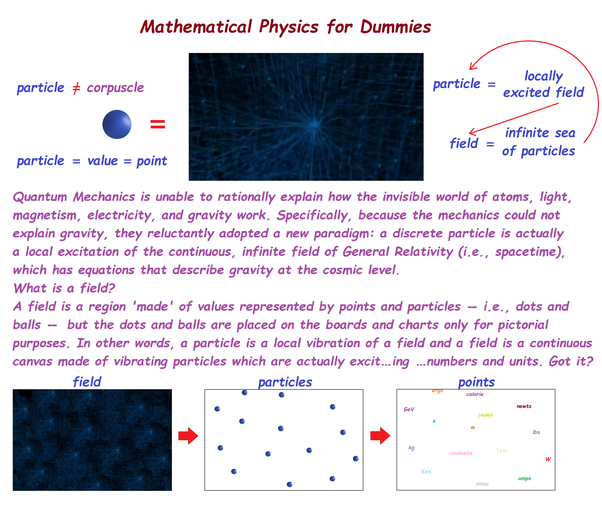The particle is the mainstay of Mathematical fizzix. Neither Quantum Mechanics nor General Relativity can do without particles. But particle doesn’t mean ‘particle’. A Quantum ‘particle’ is not a corpuscle. A Quantum ‘particle’ is not a tiny ball or bead that the particle mathematician accelerates along the beamline at CERN or SLAC or Fermilab.
So… what is a particle if not a particle?
In Mathematical ‘physics’, particle means ‘solution to an equation’. That’s it. That’s what it means to a mathematician. In a nutshell, of course! That’s the executive summary. This value could be gravity at a particular point around an object or the intensity of a magnet at a specific location near it.
What do the mathematicians represent that value on a chart or on the board with?
They represent it with a dot.
Is the point the little sphere or circle we refer to as dot?
No. The dot is really the pictorial representation of a point. The point is a value at that location. But since the mathematician cannot represent an abstract concept such as location or amount on the board, he places a dot and calls that a point.
However, Euclid’s ‘no part’ point somehow has the magical ability to morph into a material particle without anybody noticing.
The particle mathematician claims to have accelerated a particle along the beam line.
Did he accelerate a ball?
No. He is talking about the value he placed in his equation, or maybe he is referring to the solution to that equation. That’s the famous ‘particle’. The Quantum particle is by no means the classical corpuscle Newton had in mind.
So, in the end, what is a particle after all is said and done? I mean, what sense does it make to say that you accelerated a quantity? A quantity of what? How can you accelerate numbers followed by units? Did you accelerate 5 lbs? 5 lbs of what?
It is at this point that the mathematical ‘physicist’ changes gears on you and does another of his magic tricks. He says that the so-called particle he accelerates is actually an excited field.
But then what is a field?
Well, a field is a region comprised of points, each of which is pictorially depicted as a dot that represents measured values consisting of numbers followed by units. It is these mathematical abstractions that a mathematical ‘physicist’ claims that is vibrating locally and, somehow, accelerating along the accelerator beamline.
So… what have we learned? It appears that we’ve made full circle in absolute ignorance of how Mother Nature runs her invisible shop!
A particle is an excited ‘field’ which is a bunch of numbers and units surrounding an object. That’s what the Quantum theorists claim to be vibrating.

Quantum Mechanics is unable to explain how the invisible world of atoms, light, magnetism, electricity, and gravity work. Specifically, because the mechanics could not explain gravity, they reluctantly adopted a new paradigm: a discrete particle is actually a local excitation of the continuous, infinite field of General Relativity (i.e., spacetime), which has equations that describe gravity at the cosmic level.
What is a field?
A field is a region ‘made’ of values represented by points and particles – i.e., dots and balls – but the dots and balls are placed on the boards and charts only for pictorial purposes. In other words, a particle is a local vibration of a field and a field is a continuous canvas made of vibrating particles which are actually excit…ing… numbers and units. Got it?
